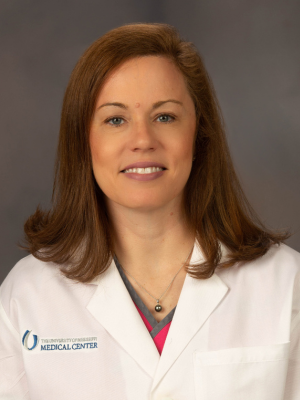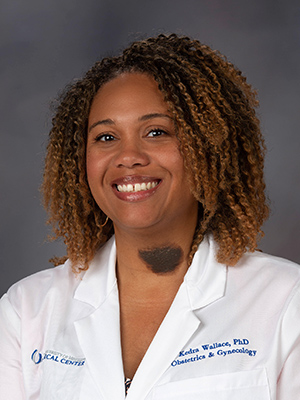Preeclampsia’s cause, treatments fuel UMMC research

Editor’s Note: Throughout this series about maternal health, we will take a closer look at the University of Mississippi Medical Center’s work through its three-part mission of education, research and health care to address the state’s maternal health crisis. These stories, which will be part of an occasional series examining the state’s only academic medical center’s role in fighting some of the most pressing health issues, share the experiences of caregivers, researchers, patients and learners. We hear from those affected by maternal health challenges and from those who are fighting against them in the hospital room, lab and classroom.

In the winter and spring of 2021, researchers at the University of Mississippi Medical Center sought to find out if an ounce of diligence and education was equal to a pound of cure when it came to hypertension in new moms.
The study marked the latest addition to the Medical Center’s longstanding research into preeclampsia, a dangerous spike in blood pressure which strikes 1 in 25 pregnancies worldwide and is a leading cause of morbidity in mothers in Mississippi.
Research has centered on the role of the placenta, which develops to protect and nourish a developing baby. UMMC researchers have been among the most active globally in the quest to find answers to why it happens in those diagnosed.

“We have the one of the largest groups of researchers studying preeclampsia in the U.S.,” said Dr. Joey Granger, professor of physiology and biophysics and former dean of the School of Graduate Studies in Health Sciences. Granger’s trailblazing research on preeclampsia began more than 25 years ago and helped UMMC become one of the top five National Institutes of Health-funded institutions in the country in that area.
UMMC ranked fourth in the U.S. in preeclampsia research and tied for 10th worldwide in terms of the number of publications produced on the subject, according to a 2022 study published in the Journal of Hypertension that tracked research in the first 20 years of the 21st century. During that span, research funding at UMMC tied to preeclampsia exceeded $58 million, with about 94% of it coming from NIH.
“The impact we’ve had on the issue has been in terms of providing knowledge on the pathophysiology of preeclampsia and discovering potential targets for treatment,” Granger said. “Right now, there’s no other treatment for it other than early delivery.”
In the recent study, a group of 250 women in central Mississippi who’d recently given birth and showed signs of stubbornly high blood pressure were handed a kit of information on preeclampsia. They were also handed a questionnaire and asked to text or call in their numbers to researchers for six weeks.
Among questions asked on pre- and post-study surveys in the Systematic Treatment and Management of PostPartum Hypertension (STAMPP) study involved the specific hypertensive condition with which each new mom was diagnosed and the directions on prescribed blood pressure meds.
Researchers at UMMC and co-collaborators at the University of Chicago noted the 191 women who remained actively engaged in the study for the full six weeks were much more likely to answer those questions correctly and show up for postpartum follow-up visits with a doctor – critical to managing their symptoms.

“The STAMPP study showed remote blood pressure monitoring goes beyond convenience,” said Dr. Rachael Morris, associate professor of maternal-fetal medicine and one of the study’s eight co-authors from UMMC and nine overall. “It delivers clinically meaningful benefits – earlier intervention, reduced complications, lower health care utilization, and better care access and equity. It also eliminated logistical and financial barriers to follow up, clinic visits and readmissions, especially for our vulnerable populations.”
STAMPP has also influenced the way clinical research is done in other areas, said Dr. Kedra Wallace, professor of pharmacology and toxicology and also a co-author on the study.

“Now, women who may only see our UMMC doctors for a short period of time and may participate in a research study are receiving direct feedback about their study results,” Wallace said. “And if they allow us to, we also send some of that feedback to their primary doctors.”
The condition, when present, typically begins about 20 weeks of pregnancy and involves high blood pressure and high protein levels in the urine. It’s not exclusive to women who had high blood pressure before their pregnancy, making its cause elusive for even seasoned researchers. Early delivery is most often recommended, following close monitoring and medications to lower and manage complications.
Preeclampsia is attributed to the deaths of about 70,000 women worldwide and can develop even after delivery, which is known as postpartum preeclampsia. In Mississippi, of 77 pregnancy-related deaths tracked by the state from 2017 through 2021, seven were confirmed to be impacted by preeclampsia, with all seven being Black, non-Hispanic women, according to the Mississippi Maternal Mortality Report, compiled in 2024 by the Mississippi State Department of Health.
In 2023, it was among complications reported by medical examiners in the death of 2016 Olympic track and field medalist and Mississippi native Tori Bowie, who was found to be about eight months pregnant and possibly in labor at the time of her death.
Novel approaches to treating the condition have been studied. In 2024, UMMC researchers aimed to develop compounds using studies on certain plant-based flavonoids that could be used in pregnant women to inhibit the onset of preeclampsia. Other research has looked at certain biomarkers that can predict the risk for developing the condition.

“Women with preeclampsia can undergo physiological changes that produce an inflammatory response and some produce antibodies,” said Dr. Babbette LaMarca, chair of pharmacology and toxicology, whose lab at UMMC has aimed to identify the mechanisms of the immune system that can cause hypertension during pregnancy. “One huge red flag is when pregnant mothers begin having bad headaches that don’t go away easily, which is usually linked to neurovascular and cardiovascular dysfunction.
“Managing preeclampsia in pregnant women is a double-edged sword for the baby as well,” LaMarca said. “You have to think about sustained growth and safety of the developing baby as well as mom’s blood pressure. So, we have to be careful what we treat women with so as not to affect the baby.
“Up to now, it’s a condition that’s been tracked only through sonograms. But soon, we’ll have a nationwide test for expectant mothers that not only tracks high blood pressure in mothers but whether certain markers for it gets passed down to their babies as well.”
One marker for this disease and its long-term consequences are specific autoantibodies, detected memorably during a stark rise in preeclampsia during the height of the COVID-19 pandemic, LaMarca said.
Studies since then by Lamarca and others from the departments of Pharmacology and Toxicology and Obstetrics and Gynecology at UMMC have examined links between having had COVID during pregnancy and the incidence of inflammatory biomarkers seen in those with preeclampsia.
“We have developed here in pharmacology a specific test for those antibodies and are the only institution in the country currently running it,” she said. “These women produce these autoantibodies well after giving birth, and we think they play an important role in them developing cardiovascular and neurovascular disease compared to women who had a normal pregnancy. Importantly, we and others have reported the presence of this antibody in patients with COVID, and it could play a role in long COVID symptoms that we know exist.”
Finding a single clue that can predict the likelihood of the condition in all women has been likened to a mythic search for a Holy Grail in some research articles.
“Some of the ongoing clinical trials can help us get there,” Granger said. “Once experimental drugs such as the compound are shown to be safe, then the Medical Center will be in a position to use some of these future drugs that will be of some benefit to expectant mothers.”
Studies on maternal health have fit into a larger picture of maternal health research at UMMC that’s been funded to the tune of $50 million the past 20 years, Granger said.
Sudden and dramatic cuts in 2025 to NIH – the largest funder of biomedical research in the world – are causes for concern going forward.
“In order to perform this research, we have to have that extramural funding to help support salaries and overhead to make progress in this field,” he said. “We’ve been very fortunate UMMC faculty has received this funding.”


